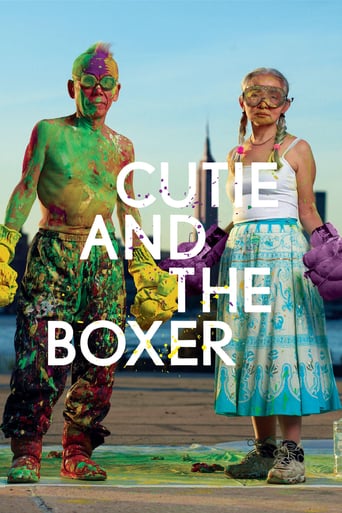

What a waste of my time!!!
... View MoreBeautiful, moving film.
... View MoreI gave this film a 9 out of 10, because it was exactly what I expected it to be.
... View MoreMostly, the movie is committed to the value of a good time.
... View MoreCUTIE AND THE BOXER is a no-holds barred documentary focusing on the 40- year marriage of Ushio Shinohara and his wife Noriko. Ushio established his reputation in Japan as a leading avant-garde artist before emigrating to the United States; since his marriage in the early Seventies, it's clear he has assumed a dominant role as artist and alcoholic, seldom taking much notice of his wife, also an artist. Zachary Heinzerling's film shows how Noriko carved out a niche for herself by creating designs for herself, focusing on a character called Cutie and her struggles for self-determination. The subjects of such designs are very closely related to Noriko's own life; it's clear she has experienced a difficult time trying to put up with a difficult husband - who throughout his life has found it hard to make a living through his art - and a son who drinks too much. It's a tribute to her stoicism that she not only manages to retain her artistic voice, but creates designs of her own that satirize her husband. Ushio, by now a reformed alcoholic, views his wife's paintings indulgently; they don't represent a threat to his masculinity, nor his status as an artist. In truth Noriko's designs are far more expressive than her husband's - although Ushio claims to produce material that will show a "new" artist, he only ever produces copies of work created several decades previously. Director Heinzerling makes no judgment on either of the protagonists, but leaves us to make up our own minds, What is perhaps most admirable is the way the couple have stayed together through thick and thin - despite their differences, they are obviously still in love with one another.
... View MoreMy wife and I have sat through countless biopics about famous artists, and after virtually every one we have the same thought: the movie would have been so much more interesting if it had focused on the artist's life partner instead of the artist. Famous artists in general are a boring bunch -- what's interesting about them is the art they produce. But the people who have to make a life with an artist -- they're the ones whose heads I want to get a peek at."Cutie and the Boxer" is a documentary about well-known artist Ushio Shinohara and his wife, Noriko. He's 80, she's 60. They live hand-to-mouth in NYC, never sure how they're going to pay their rent from one month to the next. Noriko is incredibly supportive of the self-absorbed Ushio, to the detriment of her own career as an artist. The film is a day-in-the-life story about these two and the dynamic between them. It's a portrait of a marriage that has been wildly successful on the one hand (they're still together and seem to be very much in love) and full of regret on the other (disappointment in themselves for the mess of a son they raised). Noriko teases Ushio constantly about what a jerk he is and how she doesn't know why she puts up with him. Ushio laughs but looks uneasy -- we don't blame him, because Noriko's teasings always seem to built on a foundation of true resentment.The lives of Ushio and Noriko are about as different from mine as possible, yet the thing that makes "Cutie and the Boxer" so good is its appeal is universal. Anyone who's made a true effort at building a life with a partner should find something to relate to in this film.Grade: A
... View MoreI am writing this review on Cutie and the boxer. This documentary was very magnificent and truth telling. I expected a little more for the ending of it. The art that they did in this movie was very inspiring. They were a very old and cute couple. It was very easy reading the captions. The filming of the documentary was very great. This documentary showed a lot of emotion and caring for each other and what they did. You could tell that they really loved each other. Some parts of this documentary wasn't all that good like the ending I really hated it because I expected a lot more. The more the documentary played I kind of got confused. the way they did their art was amazing and very beautiful.
... View MoreThis is a stunning film for several reasons: Foremost, it is a convincingly honest portrayal of the life of two artists. I cannot recall a film that got the life of an artist right—without an agenda, without false sentiment, without noticeable dishonesty. As a writer I felt I fully understood what Heinzerling managed to convey about the Shinoharas' personal visions without his having to resort to the conventional format of most documentaries. Second, the film is a totally engrossing portrait of a complicated relationship. Unlike most films about famous people, there is no narration here telling us what to think of Ushio and Noriko. They speak for themselves. They reveal themselves, for better and occasionally for worse. I usually resist films that are charming but this one has charm that is utterly irresistible. Third, the film casts light on the kind of work these artists do and have done. Fourth, we get to see the artists when they are not creating; that is, we get to know a little more about their inner lives and their external activities. Fifth, the artists themselves are utterly compelling personalities.
... View More